Fabrication of High-Performance Colorimetric Membrane by Incorporation of Polydiacetylene into Polyarylene Ether Nitriles Electrospinning Nanofibrous Membranes
Abstract
:1. Introduction
2. Materials and Methods
2.1. Materials
2.2. Synthesis
2.2.1. Preparation of Nanofibrous Membranes
2.2.2. Cross-Linking of Membranes
2.3. Characterization and Instruments
2.4. Thermal and pH Response Measurements
3. Result and Discussion
3.1. Chemical Structure and Morphology Analysis of Prepared PEN-PCDA
3.1.1. Chemical Structure Analysis by FT−IR Spectra
3.1.2. Morphology Analysis via SEM and TEM
3.2. Thermochromic Response Behavior
3.3. Thermo-Resistant Performance
3.4. OH−-Response Performance
4. Conclusions
Supplementary Materials
Author Contributions
Funding
Institutional Review Board Statement
Informed Consent Statement
Data Availability Statement
Conflicts of Interest
References
- Zuo, L.; Li, K.; Ren, D.; Xu, M.; Liu, X. Surface modification of aramid fiber by crystalline polyarylene ether nitrile sizing for improving interfacial adhesion with polyarylene ether nitrile. Compos. Part B-Eng. 2021, 217, 108917. [Google Scholar] [CrossRef]
- Tang, H.; Pu, Z.; Huang, X.; Wei, J.; Liu, X.; Lin, Z. Novel blue-emitting carboxyl-functionalized poly(arylene ether nitrile)s with excellent thermal and mechanical properties. Polym. Chem. 2014, 5, 3673–3679. [Google Scholar] [CrossRef]
- Liu, S.; Liu, C.; You, Y.; Wang, Y.; Wei, R.; Liu, X. Fabrication of BaTiO3-Loaded Graphene Nanosheets-Based Polyarylene Ether Nitrile Nanocomposites with Enhanced Dielectric and Crystallization Properties. Nanomaterials 2019, 9, 1667. [Google Scholar] [CrossRef] [PubMed] [Green Version]
- Lakshmana, R.V.; Saxena, A.; Ninan, K.N. Poly(arylene ether nitriles). J. Macromol.Sci. Polym. Rev. 2002, 42, 513–540. [Google Scholar] [CrossRef]
- You, Y.; Tu, L.; Wang, Y.; Tong, L.; Wei, R.; Liu, X. Achieving secondary dispersion of modified nanoparticles by hot-stretching to enhance dielectric and mechanical properties of polyarylene ether nitrile composites. Nanomaterials 2019, 9, 1006. [Google Scholar] [CrossRef] [PubMed] [Green Version]
- You, Y.; Liu, S.N.; Tu, L.; Wang, Y.J.; Zhan, C.H.; Du, X.Y.; Wei, R.B.; Liu, X.B. Controllable fabrication of poly(arylene ether nitrile) dielectrics for thermal-resistant film capacitors. Macromolecules 2019, 52, 5850–5859. [Google Scholar] [CrossRef]
- Chen, X.; Zhan, Y.; Sun, A.; Feng, Q.; Yang, W.; Dong, H.; Chen, Y.; Zhang, Y. Anchoring the TiO2@crumpled graphene oxide core–shell sphere onto electrospun polymer fibrous membrane for the fast separation of multi-component pollutant-oil–water emulsion. Sep. Purif. Technol. 2022, 298, 121605. [Google Scholar] [CrossRef]
- Jia, K.; Ji, Y.; He, X.; Xie, J.; Wang, P.; Liu, X. One-step fabrication of dual functional Tb3+ coordinated polymeric micro/nano-structures for Cr(VI) adsorption and detection. J. Hazard. Mater. 2022, 423, 127166. [Google Scholar] [CrossRef]
- Wang, P.; Liu, X.; Liu, H.; He, X.; Zhang, D.; Chen, J.; Li, Y.; Feng, W.; Jia, K.; Lin, J.; et al. Combining aggregation-induced emission and instinct high-performance of polyarylene ether nitriles via end-capping with tetraphenylethene. Eur. Polym. J. 2022, 162, 110916. [Google Scholar] [CrossRef]
- Wang, P.; Liu, X.; Wang, D.; Wang, M.; Zhang, D.; Chen, J.; Li, K.; Li, Y.; Jia, K.; Wang, Z.; et al. Recent progress on the poly(arylene ether)s-based electrospun nanofibers for high-performance applications. Mater. Res. Express 2021, 8, 122003. [Google Scholar] [CrossRef]
- Chen, X.; Zhou, G.; Peng, X.; Yoon, J. Biosensors and chemosensors based on the optical responses of polydiacetylenes. Chem. Soc. Rev. 2012, 41, 4610–4630. [Google Scholar] [CrossRef] [PubMed]
- Chen, S.W.; Chen, X.; Li, Y.; Yang, Y.; Dong, Y.; Guo, J.; Wang, J. Polydiacetylene-based colorimetric and fluorometric sensors for lead ion recognition. RSC Adv. 2022, 12, 22210–22218. [Google Scholar] [CrossRef] [PubMed]
- Narkwiboonwong, P.; Tumcharern, G.; Potisatityuenyong, A.; Wacharasindhu, S.; Sukwattanasinitt, M. Aqueous sols of oligo(ethylene glycol) surface decorated polydiacetylene vesicles for colorimetric detection of Pb2+. Talanta 2011, 83, 872–878. [Google Scholar] [CrossRef] [PubMed]
- Park, D.H.; Heo, J.M.; Jeong, W.; Yoo, Y.H.; Park, B.J.; Kim, J.M. Smartphone-based VOC sensor using colorimetric polydiacetylenes. ACS Appl. Mater. Interfaces 2018, 10, 5014–5021. [Google Scholar] [CrossRef]
- Xu, Q.; Lee, S.; Cho, Y.; Kim, M.H.; Bouffard, J.; Yoon, J. Polydiacetylene-based colorimetric and fluorescent chemosensor for the detection of carbon dioxide. J. Am. Chem. Soc. 2013, 135, 17751–17754. [Google Scholar] [CrossRef]
- Song, S.; Cho, H.B.; Lee, H.W.; Kim, H.T. Onsite paper-type colorimetric detector with enhanced sensitivity for alkali ion via polydiacetylene-nanoporous rice husk silica composites. Mater. Sci. Eng. C-Mater. 2019, 99, 900–904. [Google Scholar] [CrossRef]
- Nguyen, L.H.; Naficy, S.; McConchie, R.; Dehghani, F.; Chandrawati, R. Polydiacetylene-based sensors to detect food spoilage at low temperatures. J. Mater. Chem. C 2019, 7, 1919–1926. [Google Scholar] [CrossRef]
- Valdez, M.; Gupta, S.K.; Lozano, K.; Mao, Y. ForceSpun polydiacetylene nanofibers as colorimetric sensor for food spoilage detection. Sensor. Actuat. B-Chem. 2019, 297, 126734. [Google Scholar] [CrossRef]
- Yapor, J.P.; Alharby, A.; Gentry-Weeks, C.; Reynolds, M.M.; Alam, A.; Li, Y.V. Polydiacetylene nanofiber composites as a colorimetric sensor responding to escherichia coli and pH. ACS Omega 2017, 2, 7334–7342. [Google Scholar] [CrossRef] [Green Version]
- Guo, H.; Zhang, J.; Porter, D.; Peng, H.; Löwik, D.W.P.M.; Wang, Y.; Zhang, Z.; Chen, X.; Shao, Z. Ultrafast and reversible thermochromism of a conjugated polymer material based on the assembly of peptide amphiphiles. Chem. Sci. 2014, 5, 4189–4195. [Google Scholar] [CrossRef]
- Baek, J.; Joung, J.F.; Lee, S.; Rhee, H.; Kim, M.H.; Park, S.; Yoon, J. Origin of the reversible thermochromic properties of polydiacetylenes revealed by ultrafast spectroscopy. J. Phys. Chem. Lett. 2016, 7, 259–265. [Google Scholar] [CrossRef] [PubMed]
- Huo, J.; Hu, Z.; He, G.; Hong, X.; Yang, Z.; Luo, S.; Ye, X.; Li, Y.; Zhang, Y.; Zhang, M.; et al. High temperature thermochromic polydiacetylenes: Design and colorimetric properties. Appl. Surf. Sci. 2017, 423, 951–956. [Google Scholar] [CrossRef]
- Scoville, S.P.; Shirley, W.M. Investigations of chromatic transformations of polydiacetylene with aromatic compounds. J. Appl. Polym. Sci. 2011, 120, 2809–2820. [Google Scholar] [CrossRef]
- Carpick, R.W.; Sasaki, D.Y.; Marcus, M.S.; Eriksson, M.A.; Burns, A.R. Polydiacetylene films: A review of recent investigations into chromogenic transitions and nanomechanical properties. J. Physics-Condens. Mat. 2004, 16, R679–R697. [Google Scholar] [CrossRef] [Green Version]
- Alam, A.K.M.M.; Jenks, D.; Kraus, G.A.; Xiang, C. Synthesis, fabrication, and characterization of functionalized polydiacetylene containing cellulose nanofibrous composites for colorimetric sensing of organophosphate compounds. Nanomaterials 2021, 11, 1869. [Google Scholar] [CrossRef] [PubMed]
- Yoon, B.; Shin, H.; Kang, E.M.; Cho, D.W.; Shin, K.; Chung, H.; Lee, C.W.; Kim, J.M. Inkjet-compatible single-component polydiacetylene precursors for thermochromic paper sensors. ACS Appl. Mater. Interfaces 2013, 5, 4527–4535. [Google Scholar] [CrossRef] [PubMed]
- Dong, W.; Lin, G.; Wang, H.; Lu, W. New dendritic polydiacetylene sensor with good reversible thermochromic ability in aqueous solution and solid film. ACS Appl. Mater. Interfaces 2017, 9, 11918–11923. [Google Scholar] [CrossRef] [PubMed]
- Liu, W.; Zeng, C.; Ge, F.; Yin, Y.; Wang, C. Realization of reversible thermochromic polydiacetylene through silica nanoparticle surface modification. J. Appl. Polym. Sci. 2020, 138, 49809. [Google Scholar] [CrossRef]
- Sutapin, C.; Mantaranon, N.; Chirachanchai, S. Eight-armed polydiacetylene under benzoxazine dimer branched polylactide: A structural combination for reversible thermochromic effects and a model case for free-standing poly(lactic acid) films. J. Mater. Chem. C 2017, 5, 8288–8294. [Google Scholar] [CrossRef]
- Lee, S.; Lee, J.; Kim, H.N.; Kim, M.H.; Yoon, J. Thermally reversible polydiacetylenes derived from ethylene oxide-containing bisdiacetylenes. Sensor. Actuat. B-Chem. 2012, 173, 419–425. [Google Scholar] [CrossRef]
- Ge, J.C.; Kim, J.Y.; Yoon, S.K.; Choi, N.J. Fabrication of low-cost and high-performance coal fly ash nanofibrous membranes via electrospinning for the control of harmful substances. Fuel 2019, 237, 236–244. [Google Scholar] [CrossRef]
- Ge, J.C.; Wu, G.; Yoon, S.K.; Kim, M.S.; Choi, N.J. Study on the preparation and lipophilic properties of polyvinyl alcohol (PVA) nanofiber membranes via green electrospinning. Nanomaterials 2021, 11, 2514. [Google Scholar] [CrossRef] [PubMed]
- Jeon, H.; Lee, J.; Kim, M.H.; Yoon, J. Polydiacetylene-based electrospun fibers for detection of HCl gas. Macromol. Rapid Commun. 2012, 33, 972–976. [Google Scholar] [CrossRef]
- Alam, A.; Yapor, J.P.; Reynolds, M.M.; Li, Y.V. Study of polydiacetylene-poly (ethylene oxide) electrospun fibers used as biosensors. Materials 2016, 9, 202. [Google Scholar] [CrossRef] [PubMed]
- Mapazi, O.; Matabola, K.P.; Moutloali, R.M.; Ngila, C.J. High temperature thermochromic polydiacetylene supported on polyacrylonitrile nanofibers. Polymer 2018, 149, 106–116. [Google Scholar] [CrossRef]
- Yang, X.; Li, Y.; Lei, W.; Liu, X.; Zeng, Q.; Liu, Q.; Feng, W.; Li, K.; Wang, P. Thermal degradation behaviors of poly (arylene ether nitrile) bearing pendant carboxyl groups. Polym. Degrad. Stabil. 2021, 191, 109668. [Google Scholar] [CrossRef]
- Wang, P.; Jia, K.; Zhang, D.; Li, K.; Zeng, D.; He, X.; Shen, X.; Feng, W.; Wang, Y.; Yang, X.; et al. Structure-property and bioimaging application of the difunctional polyarylene ether nitrile with AIEE feature and carboxyl group. Polymer 2021, 217, 123459. [Google Scholar] [CrossRef]
- Tang, H.; Yang, J.; Zhong, J.; Zhao, R.; Liu, X. Synthesis and dielectric properties of polyarylene ether nitriles with high thermal stability and high mechanical strength. Mater. Lett. 2011, 65, 2758–2761. [Google Scholar] [CrossRef]
- He, L.; Tong, L.; Bai, Z.; Lin, G.; Xia, Y.; Liu, X. Investigation of the controllable thermal curing reaction for ultrahigh Tg polyarylene ether nitrile compositions. Polymer 2022, 254, 125064. [Google Scholar] [CrossRef]
- Charoenthai, N.; Pattanatornchai, T.; Wacharasindhu, S.; Sukwattanasinitt, M.; Traiphol, R. Roles of head group architecture and side chain length on colorimetric response of polydiacetylene vesicles to temperature, ethanol and pH. J. Colloid Interf. Sci. 2011, 360, 565–573. [Google Scholar] [CrossRef]
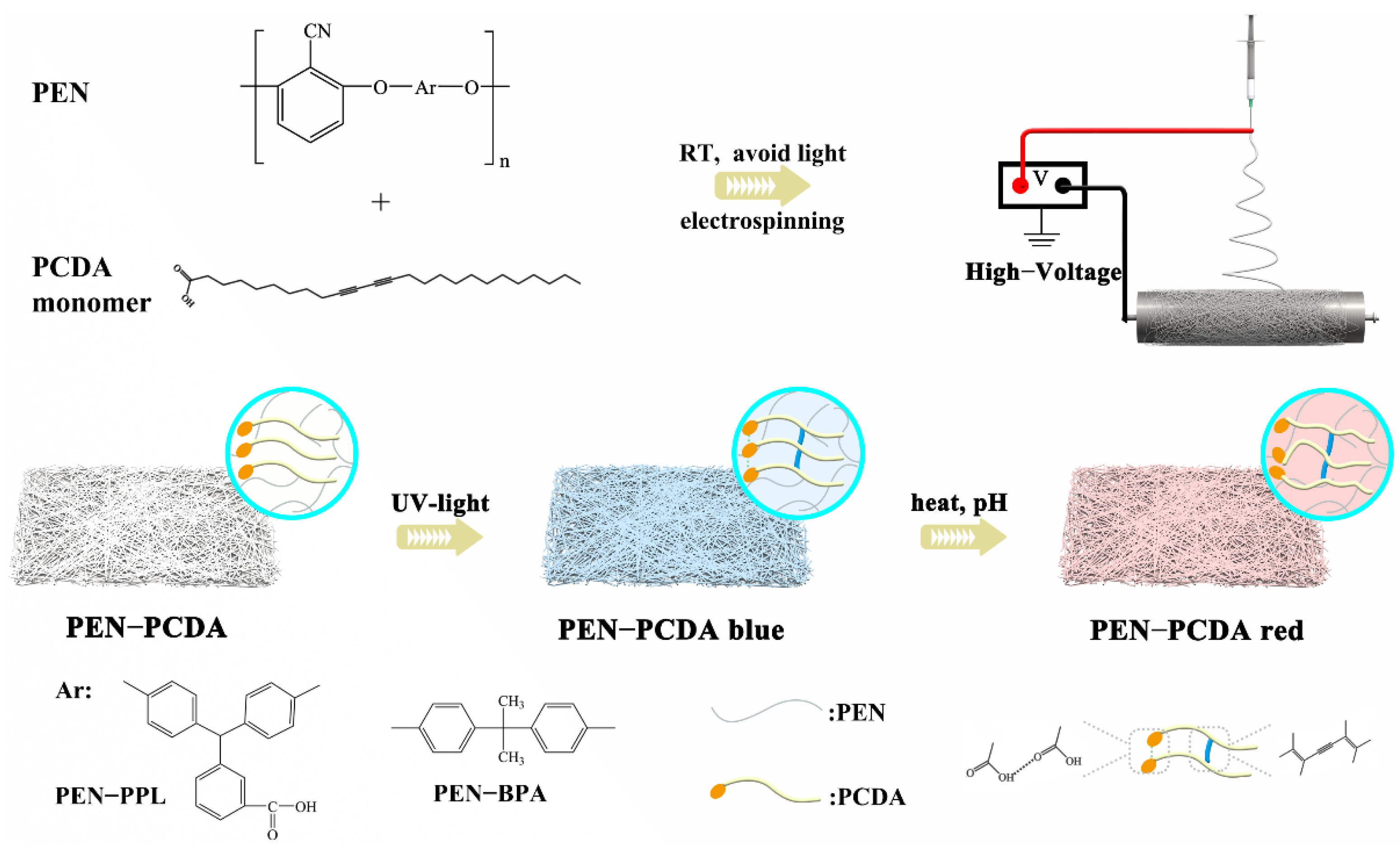
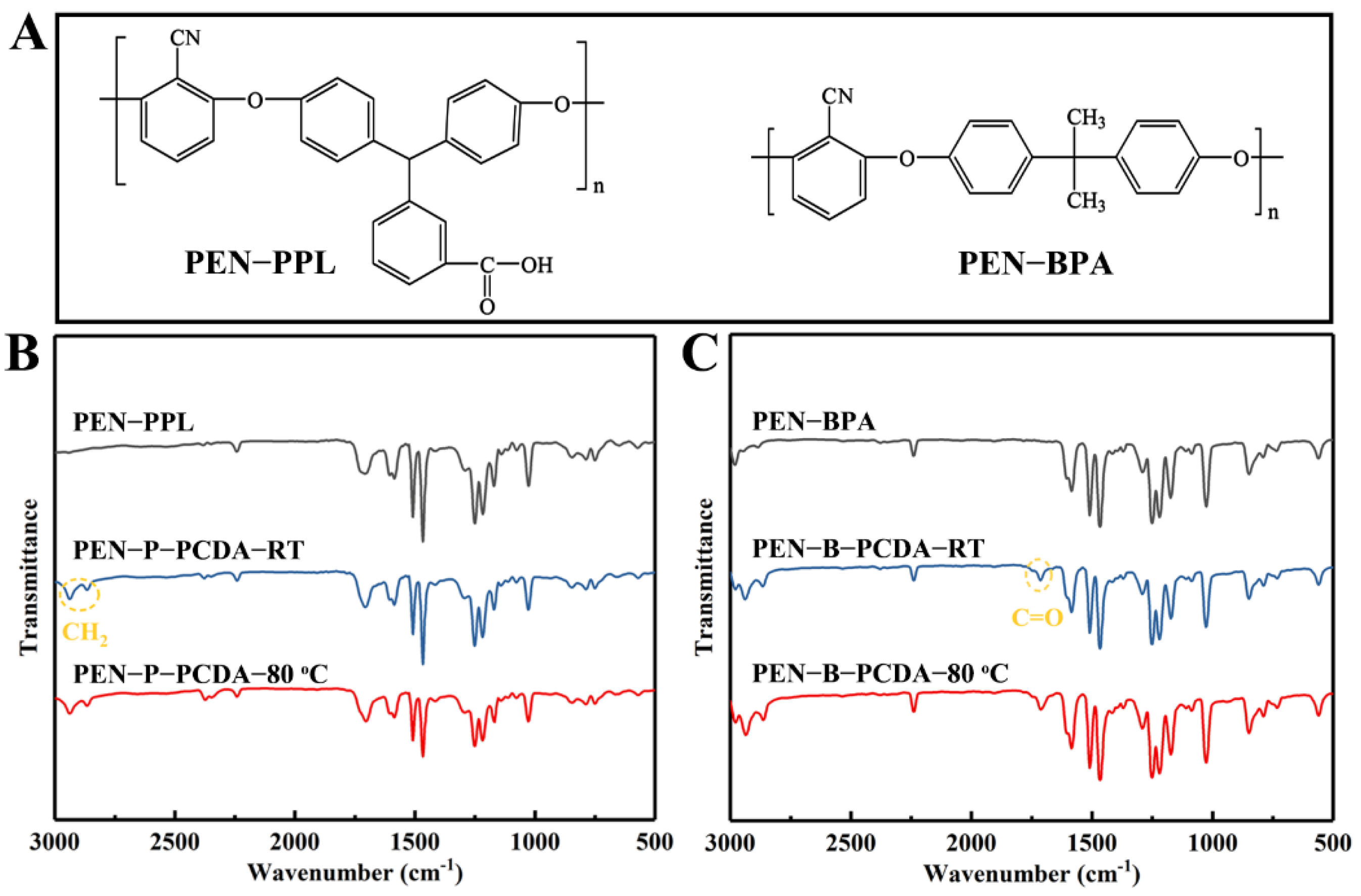


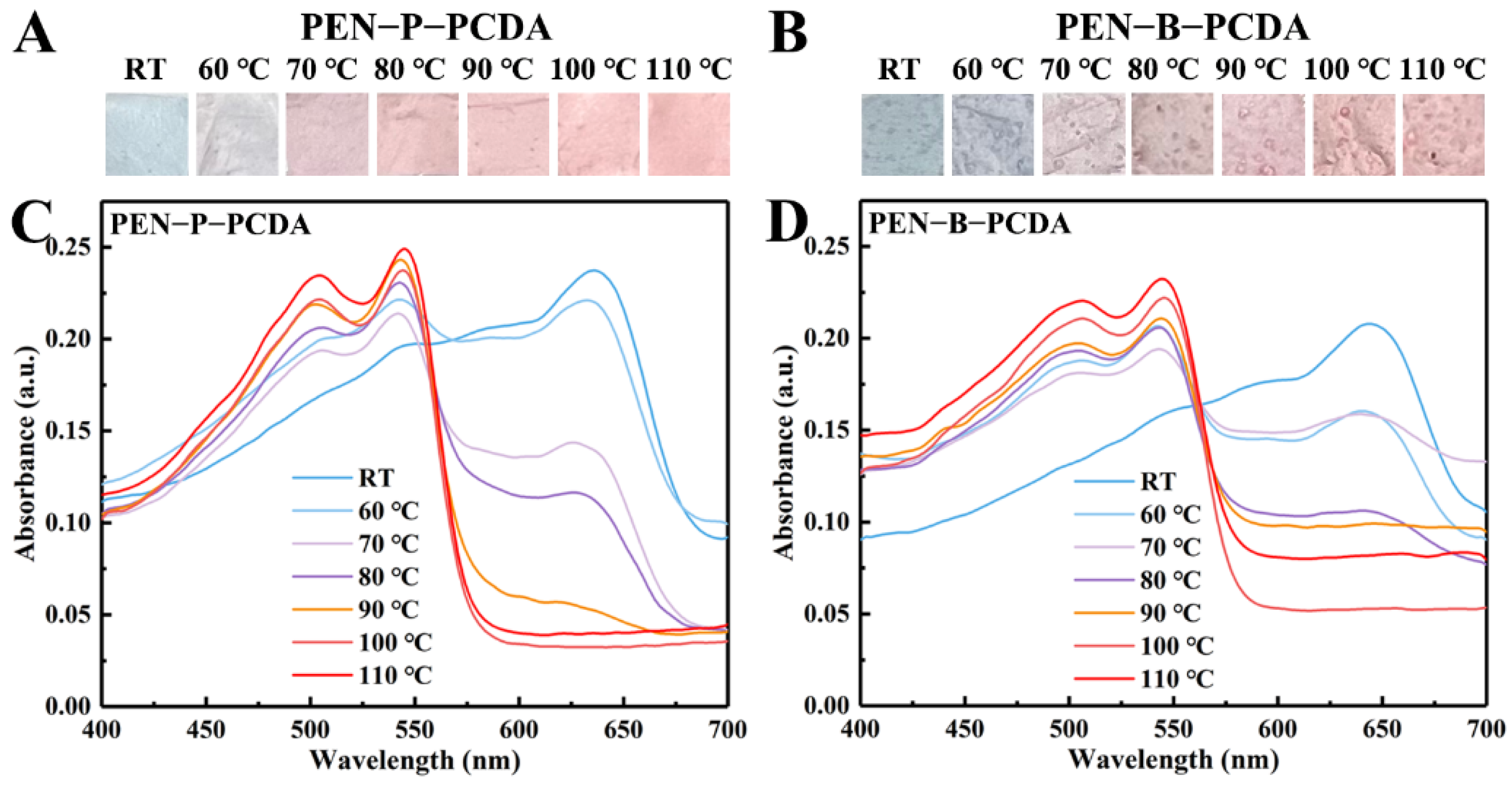
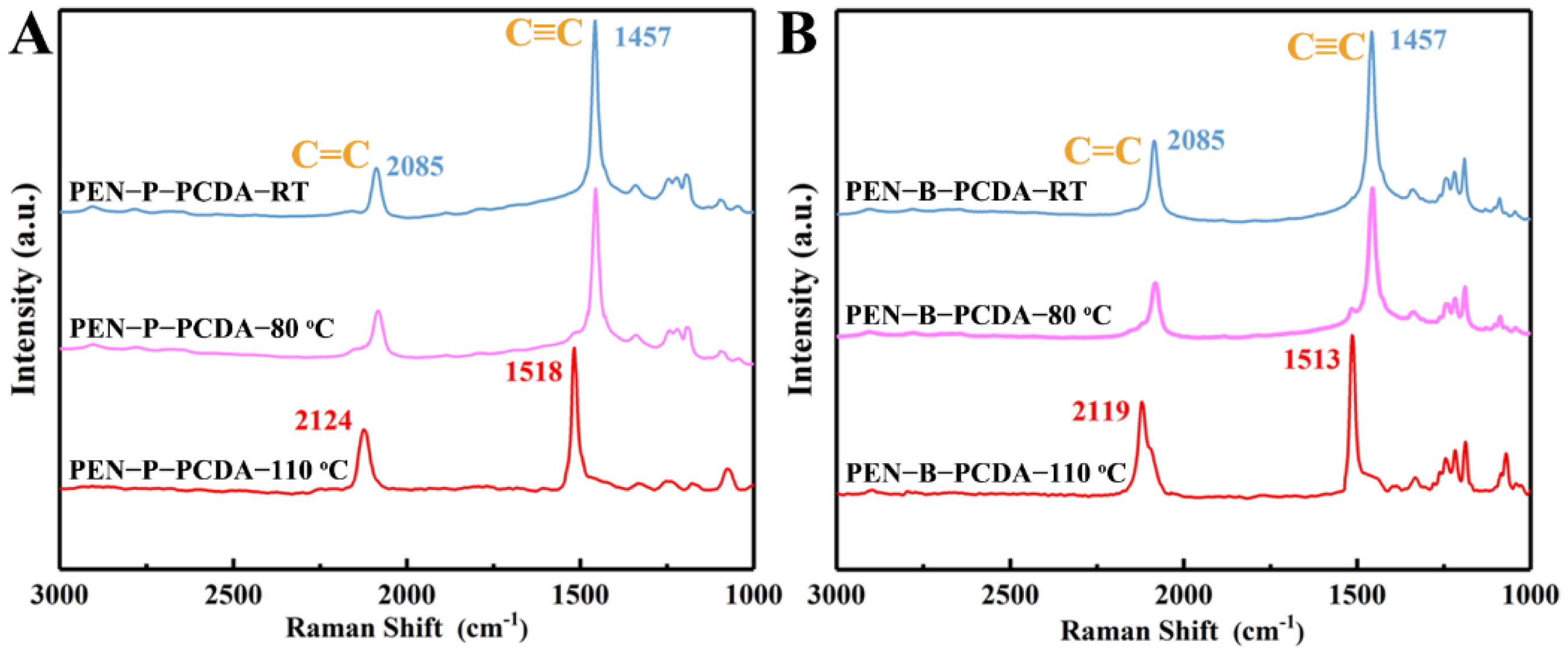
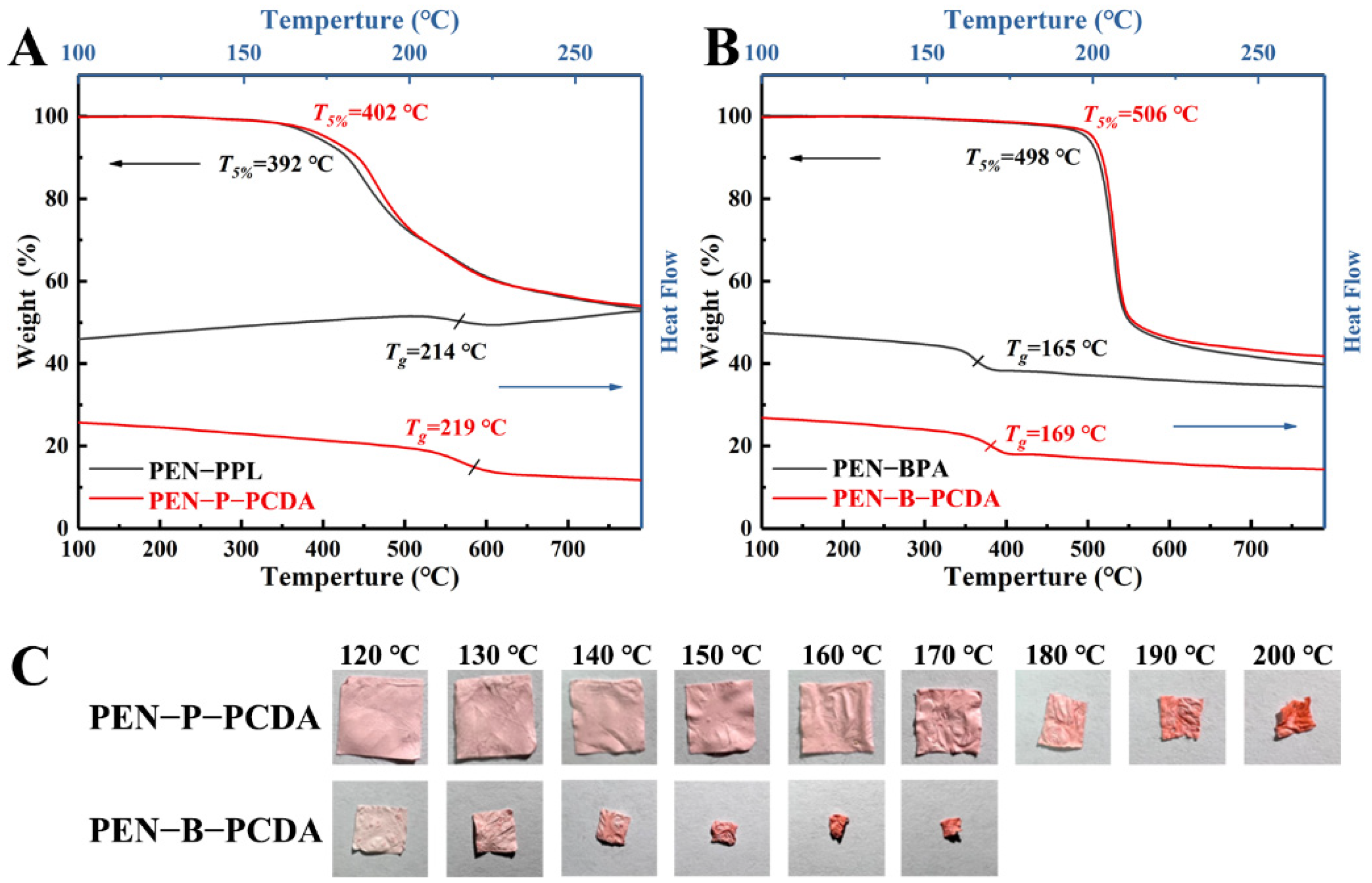

Publisher’s Note: MDPI stays neutral with regard to jurisdictional claims in published maps and institutional affiliations. |
© 2022 by the authors. Licensee MDPI, Basel, Switzerland. This article is an open access article distributed under the terms and conditions of the Creative Commons Attribution (CC BY) license (https://creativecommons.org/licenses/by/4.0/).
Share and Cite
Wang, P.; Liu, X.; You, Y.; Wang, M.; Huang, Y.; Li, Y.; Li, K.; Yang, Y.; Feng, W.; Liu, Q.; et al. Fabrication of High-Performance Colorimetric Membrane by Incorporation of Polydiacetylene into Polyarylene Ether Nitriles Electrospinning Nanofibrous Membranes. Nanomaterials 2022, 12, 4379. https://doi.org/10.3390/nano12244379
Wang P, Liu X, You Y, Wang M, Huang Y, Li Y, Li K, Yang Y, Feng W, Liu Q, et al. Fabrication of High-Performance Colorimetric Membrane by Incorporation of Polydiacetylene into Polyarylene Ether Nitriles Electrospinning Nanofibrous Membranes. Nanomaterials. 2022; 12(24):4379. https://doi.org/10.3390/nano12244379
Chicago/Turabian StyleWang, Pan, Xidi Liu, Yong You, Mengxue Wang, Yumin Huang, Ying Li, Kui Li, Yuxin Yang, Wei Feng, Qiancheng Liu, and et al. 2022. "Fabrication of High-Performance Colorimetric Membrane by Incorporation of Polydiacetylene into Polyarylene Ether Nitriles Electrospinning Nanofibrous Membranes" Nanomaterials 12, no. 24: 4379. https://doi.org/10.3390/nano12244379
APA StyleWang, P., Liu, X., You, Y., Wang, M., Huang, Y., Li, Y., Li, K., Yang, Y., Feng, W., Liu, Q., Chen, J., & Yang, X. (2022). Fabrication of High-Performance Colorimetric Membrane by Incorporation of Polydiacetylene into Polyarylene Ether Nitriles Electrospinning Nanofibrous Membranes. Nanomaterials, 12(24), 4379. https://doi.org/10.3390/nano12244379






